
Beyond The Frame: The Professionals
Looking back at some expert cinematography by Conrad L Hall, ASC and his Dream Team behind the camera.
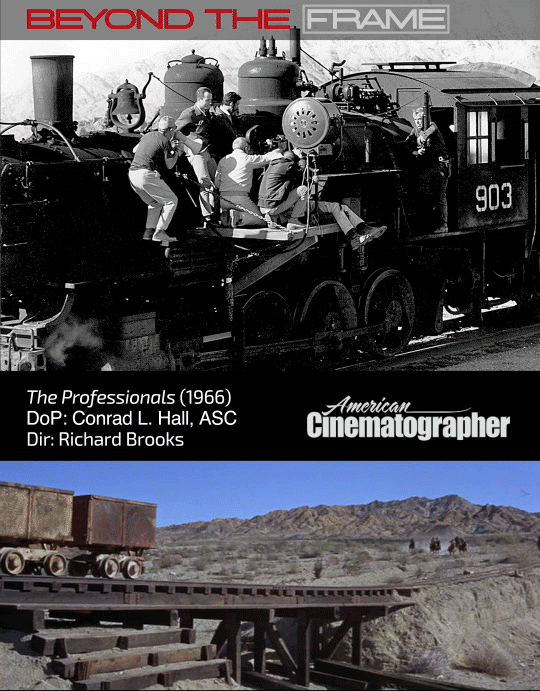
Actor Lee Marvin seemingly holds on for dear life while shooting the Western adventure The Professionals (1966), directed by Richard Brooks (far left, with megaphone) and photographed by Conrad L. Hall, ASC (third from left, standing). At the eyepiece is operator William A. Fraker, while at his side is possibly Jordan Cronenweth or Bobby Byrne, both camera assistants on the show, and all future ASC greats. (Yes, really — an incredible Dream Team.) Another future ASC member, Charles Rosher, Jr, was an uncredited operator on the show.
The picture earned Hall his second Academy Award nomination. It also marked his first collaboration with director Brooks, with whom he also would shoot In Cold Blood and The Happy Ending. “Richard was an auteur,” Hall noted. “He’d had a lot of experience writing and directing, and he was a very strong visualist with firm ideas. He liked to have a very close working relationship with his cinematographer. You lived with him and ate with him, and you were always talking about the story and planning ahead. More likely than not, if you had an idea he'd thought of it already, so it became a matter of making his ideas work rather than coming up with your own. He was very certain about his ideas, very passionate. I loved working with him. We were friends.”
In the late 1990s, Hall and members of his team on the picture held a mini reunion at the ASC Clubhouse:
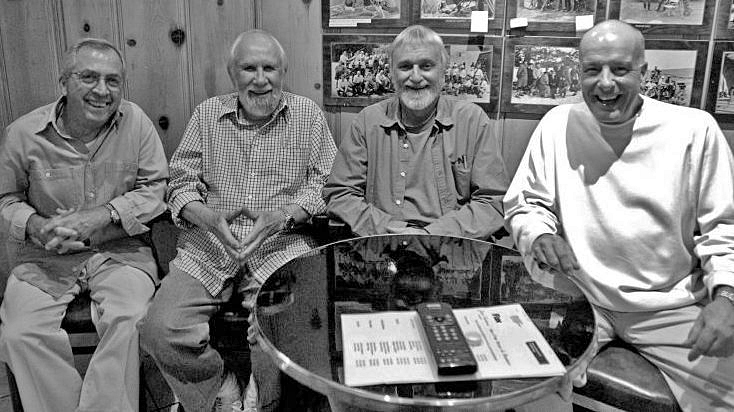
Below is the American Cinematographer cover story (Feb., 1967) on the shooting of the film:
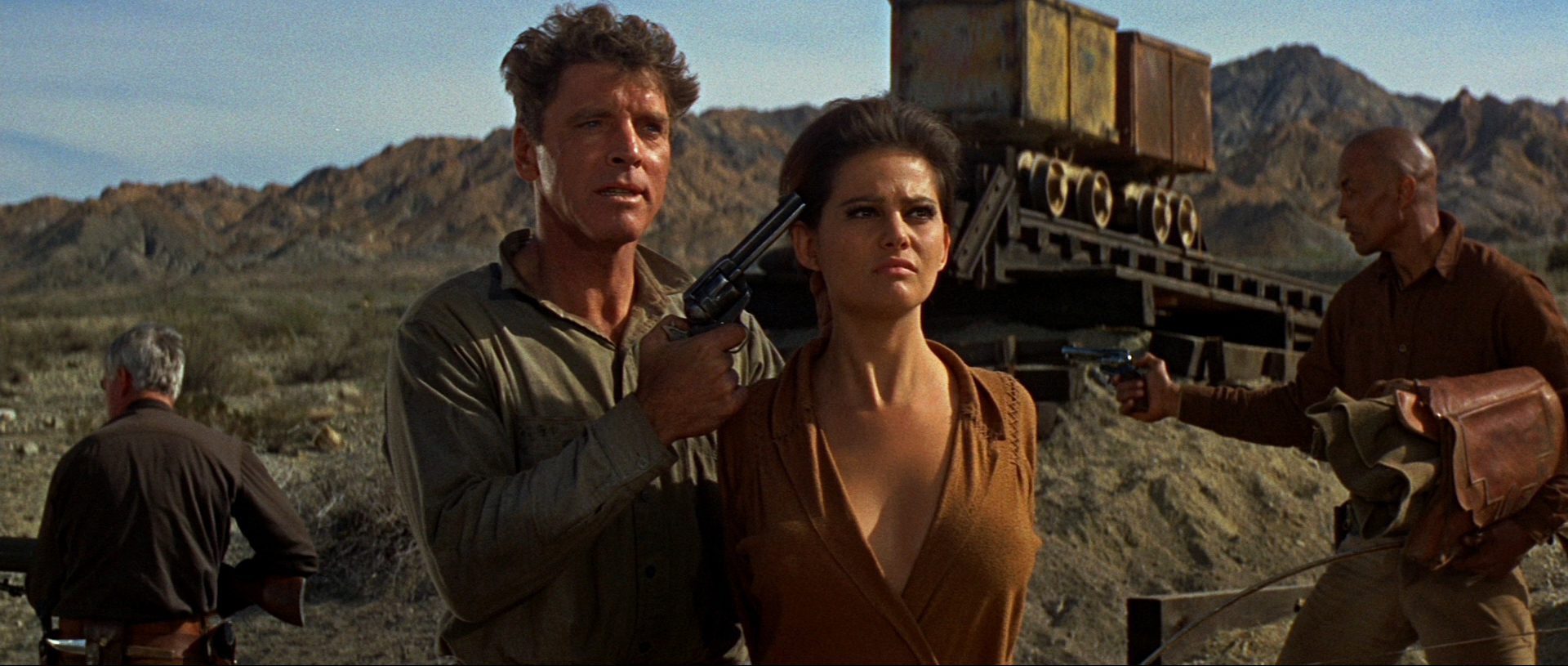
The Photography of The Professionals
Hard-hitting outdoor action-adventure film, produced under difficult conditions, features inspired direction and superb color cinematography.
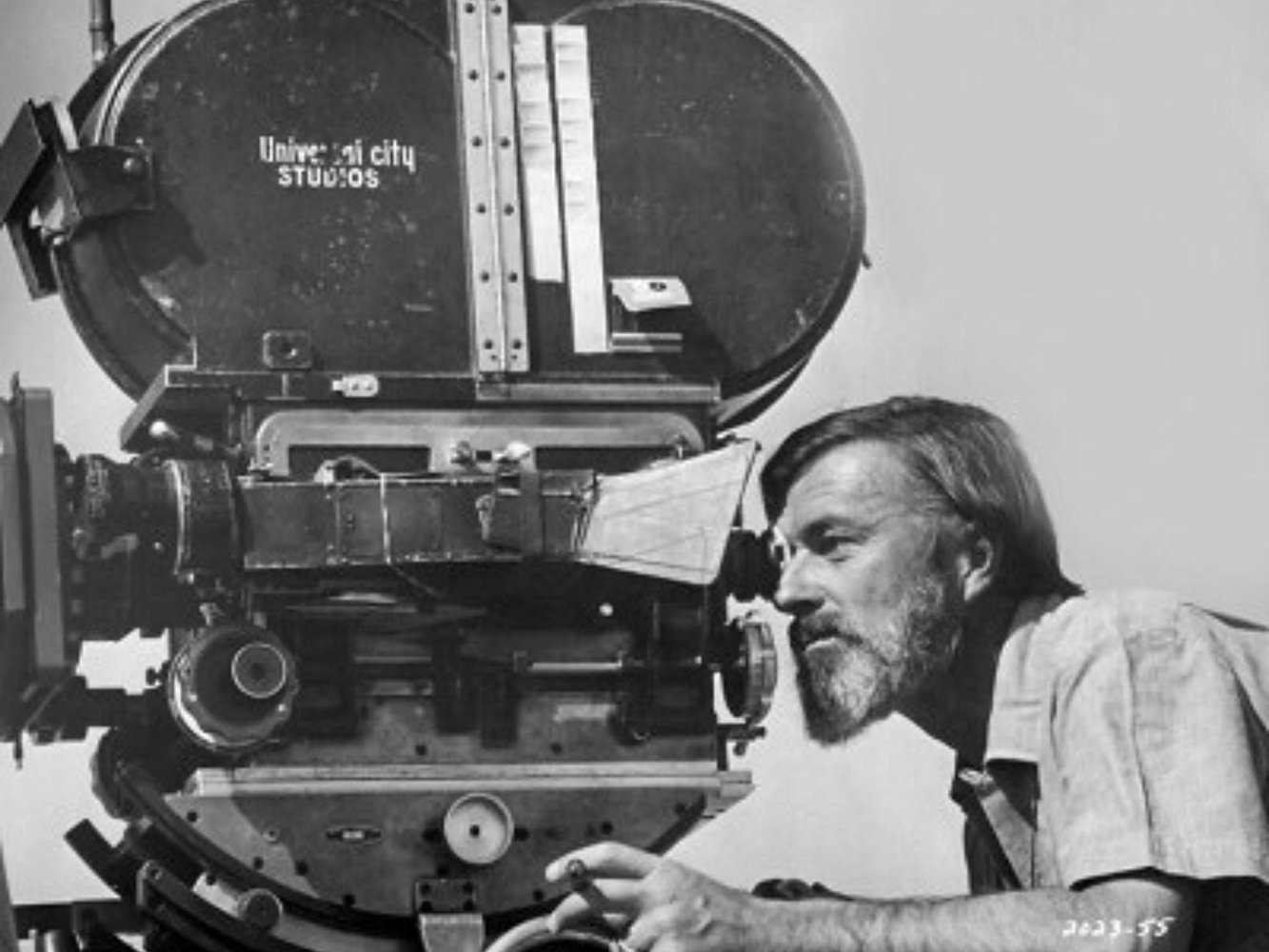
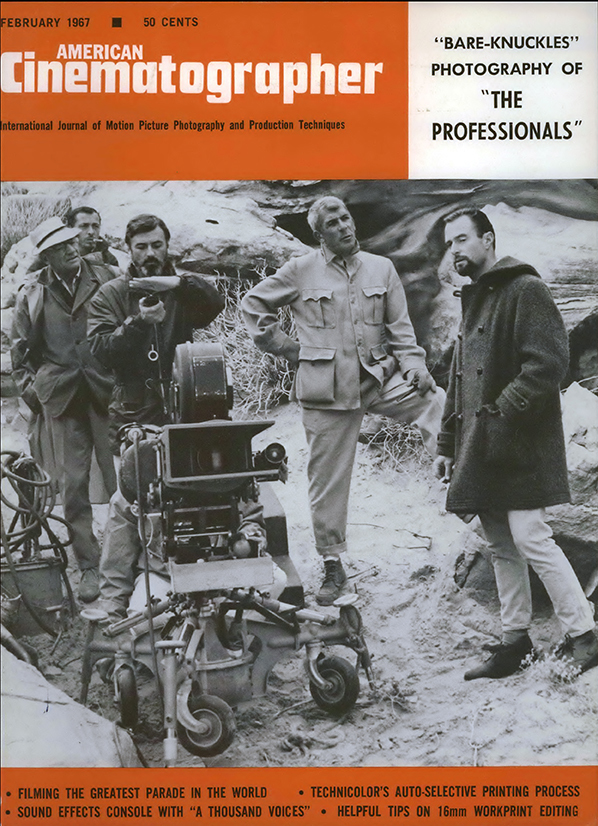
The Professionals is a film made by professionals — and that fact is evident on every frame. Written for the screen and directed by Richard Brooks, the Columbia Pictures release fills the wide-screen with an explosion of dramatic excitement photographed in Panavision and Technicolor by Conrad Hall. Though its locale is the rugged American West, The Professionals is a cut far above the genre of motion pictures usually lumped into the general category of Westerns. It is, rather, a bare-knuckled action-adventure film — with a definite emphasis on action — which gets up and moves, and keeps going, until two hours have miraculously flown by.
In perhaps no other type of motion picture is the art of cinematography quite so pivotal as in the outdoor film. The cinematographer, usually working on location far from the conveniences of the soundstage, is called upon to make Nature perform visually as an integral part of the action. He must control the basically uncontrollable elements of weather and terrain — and go right on shooting even when conditions approach the impossible, because budget and schedule wait for no man. In The Professionals, director of photography Hall has done all this while creating a gutsy, virile style of camera artistry which is perfectly in key with the hard-hitting story.
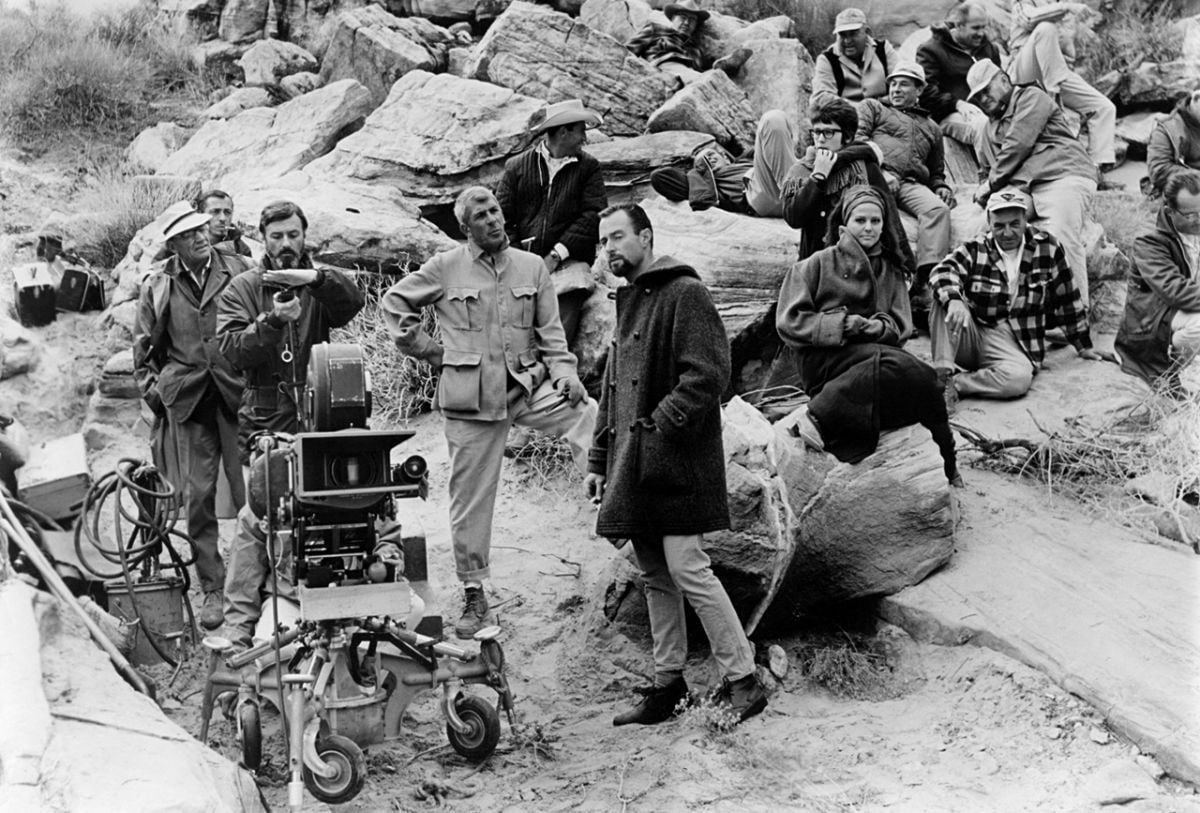
Nature in All Its Deadly Beauty
In barest outline only, the story conforms to the classic “chase” formula — but any suggestions of stereotype ends right there. Four “professionals” (each a specialist in an important skill of 1917 Western survival) are hired by an American millionaire to retrieve his beautiful wife, who has been kidnapped and spirited off to a Mexican stronghold by a cutthroat chieftain. The quartet includes a dynamiter, a weapons and tactics expert, a boss wrangler-packmaster and “the most dependable scout and tracker in the territory.”
Except for a very few interiors and one night exterior, the entire action of the film was filmed in spectacular natural locations which included Death Valley, the Valley of Fire State Park (near the upper reaches of Lake Mead in Nevada) and a rail spur line 50 miles east of Indio, California. Meant to simulate the badlands of northern Mexico, these locales appear like landscapes in Hell — tortured, volcanic deserts deadly to human survival, but stunningly pictorial to the eye of the widescreen color camera. The murderous heat and terrain are as much the enemy as is the Mexican bandido, and the entire visual treatment of the film makes this emphatic.
“By its very nature it was a difficult picture to make,” observes Conrad Hall, “but we actually encountered few problems which had not been foreseen, because the filming was very carefully planned in advance. I had been assigned to work on the film two months before shooting began and had made numerous trips with Richard Brooks to the various locations. We had discussed how, where and when we would shoot each sequence, so that actual production could progress as rapidly as possible. The gaffer, the key-grip, the property man and other leading technicians came onto the picture when I did. Assigned that far in advance of shooting, we were keyed to a tremendous pitch of efficiency as a result of being involved in every stage of planning of the film. For the cinematographer this is great, because it allows him to assume full responsibility for the picture’s photographic quality. In order to make things happen visually correct for the director, he should have the benefit of every piece of knowledge available about the circumstances involved. If, however, he is brought in only a few days before shooting begins, when all the basic decisions about sets and locations have already been made, then his hands are tied. He is not really responsible if things don’t go well — and he should be responsible.”
Action As Big As All Outdoors
Although cinematic quality was the prime consideration in the production of The Professionals, time was also of the essence. Brooks realized that he had a great deal of story to tell, but he had firmly resolved in advance that he did not want to make a lengthy roadshow type of spectacle. The finished cut, he decided, was not to exceed two hours.
In order to tell his story fully within that time limit without being forced to drop out whole scenes or sequences should the cut threaten to run too long, an extremely thorough coverage in terms of separate camera angles and setups was necessary. This gave him the leeway to telescope action by trimming individual scenes instead of eliminating whole segments of the story, as is usually done when a picture runs long. It also provided him with the means to create the extraordinary pace which is maintained throughout.
An 87-day shooting schedule was set for the film. In actual production, an average of twenty setups per day were shot. There was no second unit involved. Brooks directed and Hall photographed every single scene in the film, down to the most insignificant insert. Filming was completed in exactly 87 days.
Principal photography began in Death Valley with sequences showing the retreat toward the border after the wife has been recaptured from her abductors. There are some striking scenes around a desert salt pool and an all-too-realistic sandstorm created by throwing sand and Fuller’s earth in front of giant wind machines.
Sequences filmed near Indio included all of the action having to do with the train and the goat-keeper’s camp, established in the midst of a pictorial array of abandoned boxcars. Here the problems included shooting aboard the fast-moving train (without benefit of process-screen) and balancing artificial illumination for interiors of boxcars with brilliantly sunlighted exteriors prominent in the background.
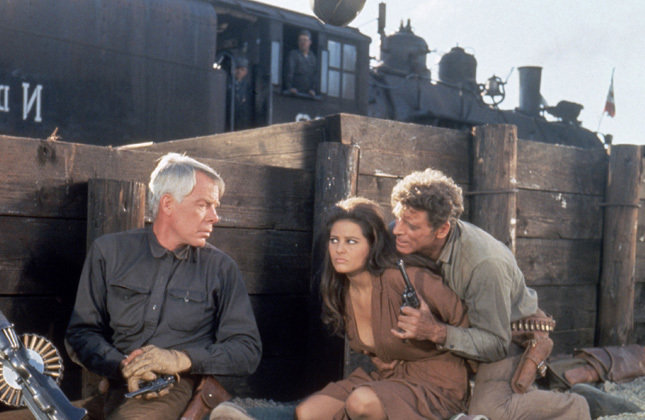
Darkness at Noon
Because a considerable portion of the action in The Professionals takes place at night and because the vastness of the landscapes precluded lighting them night-for-night, the film includes a good deal of day-for-night photography.
In order to darken the skies sufficiently for the effect, Hall employed a combination of pola-screen and graduated neutral density filter, plus the customary 2 ½ stops of underexposure. Since a polarizing filter acts as a variable depth filter for that portion of the sky at right angles to the sun, and because its effectiveness depends upon the relationship of camera angles to sun angle, it is theoretically impossible to maintain a consistency of correction when any considerable degree of panning is involved within a continuous scene.
Because the spirited action of the film sometimes involved pans of up to 180 degrees, Hall had to work out some method overcoming this limitation. This he did by adopting a high camera angle with the opening composition including a generous area of correctly polarized sky. Then, as he panned people and horses past the camera position, he would tilt down off the sky — meanwhile changing the axis of polarization of the pola-screen — so that when he panned and tilted back up to the ending composition, the sky would be adequately corrected.
Hall admits that in his zeal to make a certain flatlighted scene look like night he over-polarized it slightly, with the result that the actors’ faces appear somewhat lifeless. Since one of the functions of a pola-screen is to eliminate reflections, it is understandable that it also tends to blank out highlights on skin tones when too great a degree of correction is used. Because the scene in question was a fairly long shot, however, the error was not critical enough to warrant reshooting it.
Like many cinematographers, Hall prefers, whenever possible, to shoot actors in backlight for day-for-night photography. In anything but a close shot he employs little or no fill-light — simply a liner to separate the faces from the background. In closer shots, where it is important to see the features of a player, he mounts an arc or 10-KW unit directly from the front, bouncing the light off of the actor’s clothes so that just the face is illuminated.
Deadly Enemy of Day-for-Night
Hall deplores the fact that certain technical conditions sometimes make it necessary to “print up” day-for-night scenes so that their original richness is washed out.
“The cameraman’s nemesis is the drive-in theater,” he explains. “Because of the special projection problems involved in such situations, it becomes necessary to print the night scenes much lighter if they are to show up at all. However, when one of these prints is released for conventional theater screening, the day-for-night scenes project so light that they appear almost like daylight. This is rather discouraging when a cameraman has worked hard to create a true, rich night effect.”
A day-for-night illusion is especially difficult to achieve in a flat desert location where there are no trees or other shadow-producing elements and no practical lights in the scene. In the case of The Professional the problem was compounded by the fact that extremely light sand dunes were prominent in certain sequences. While these would normally be the brightest area of a composition on a moonlit night, they were, in this case, so bright as to be far out of balance with the rest of the scene. Filters could be used to knock down the sky, but no amount of overall filtering would hold back the sand dunes specifically.
“A little trick I picked up from my old pal, Ted McCord, ASC, came in handy for solving this problem,” Hall observes. “Neutral density gelatin filters were carefully cut to mask just the sand dune areas of a scene. These gels were pasted directly onto the front element of the lens by means of transparent cellophane tape. Because these masks were so far from the focal plane of the lens, the sharp edges were fuzzed out almost as if some kind of graduated filter had been used. This worked very successfully to bring the sand into balance with the rest of the scene. Of course, you couldn’t pan on such a scene because the neutral gel ‘masks’ would have moved right along with the lens.”
The problem of auxiliary lighting for outdoor sequences was complicated by the fact that many of the actual shooting sites were inaccessible to such professional equipment as arcs, generators and the lengthy cables needed to make them work.
Hall, who dislikes the look of obviously artificial light in a natural situation, often resorted to reflectors, mainly to kick highlights into an otherwise lifeless background. Where it became necessary to fill the faces of actors while shooting in some out-of-the-way places, he used battery-operated quartz-iodine lamps.
Blueprint for a Bandit’s Lair
The most complex segment of filming on The Professionals — and one which accounted for nine weeks of the total shooting schedule — was that which took place in the starkly beautiful Valley of Fire State Park 60 miles north of Las Vegas.
This is a relatively undeveloped area of savagely twisted re-rock sculpture which Brooks, Hall and assistant director Tom Shaw had explored by cross-country jeep, since the area boasted few roads other than the main highway which runs through it. Sites for the various sequences to be filmed in this location were carefully selected with special attention being given to that of a ruined hacienda covering several acres (the hideout of the bad guys) which is the focal point of the climactic action.
Discussions with state authorities led to their agreeing to build a 7-mile dirt and gravel road leading into the shooting area so that the huge units of studio rolling stock could be accommodated. However, since it had not rained in this area for the past 60 or 70 years, it was not considered necessary to install culverts of any kind — a decision which later proved to be grossly over-optimistic.
Because the hacienda was to serve as the set for complex daylight and night-for-night photography, its layout in a flat area surrounded by towering boulders was most critical. Since a sand deposit formed the natural base of the area, tons of clay were trucked in and spread flat to serve as a more solid foundation for the construction of art director Edward S. Haworth’s ruggedly picturesque hacienda.
Cliff-hanging Parallels
Sites for several of the camera angles were established 75 to 100 feet up sheer 45 degree rock slopes towering above the flat area. In anticipation of the lighting problems attendant to this precarious terrain, special parallels were designed with steel points on the legs which could be pounded into the sandstone cliffs. Other camera and lighting “platforms” were carved out of the mountainside. To get the lamps up to these lofty vantage points, crew members simply roped them to their backs and scaled the cliffs like mountain-climbers. These units consisted mainly of Senior, Junior and Baby incandescent spots, because bulkier units could not have been handled in this way.
The overall key-light, to simulate moonlight bathing the football field-sized flat area, was provided by a single Titan arc borne aloft by a giant crane of the type known as a “cherry picker.” On the ground, lighting of the hacienda ruin and tents surrounding it was accomplished with 11 Brute arcs and numerous 10-KW incandescent units. This lighting, which Hall describes as being purposely “sketchy” is actually a triumph of precise placement of lamps to illuminate selected planes and areas of the huge expanse. By lighting the curve of an arch here and the side of a tent there, an effect of tremendous depth was created.
“As all of the great cinematographer have already said,” Hall observes, “in really good photography, you light just a few things — whatever is important — and you resist the impulse to add that extra light that will nullify several fires burning in the scene. Fires provide little actual illumination but they expose the film where they are and give the scene an illusion of being fully lighted when it actually isn’t.”
In order that the hacienda would not seem to exist against a limbo of black velvet, it was necessary to do some lighting of the cliffs forming the perimeter. However, since these cliffs were composed of light-colored rock, it was not required to deploy very many lamp units for this purpose. The average working level of illumination for the lengthy hacienda night-for-night sequence was 100 foot-candles, while some scenes were photographed at an incredible 32 foot-candles — without it being necessary to “push” the film in development.
The Titan arc, serving as overall key-light for the area was fitted with white flame carbon and a half MT-2 filter, which produced a pale steel-blue light of approximately 4500 degrees Kelvin, closely resembling the cold tone of moonlight. Since sources for all other light in the set had been established as either firelight or lantern light, the Brute arcs used were fueled with yellow flame carbon and half MT-2 filters were placed over the incandescent units to warm them up slightly more than 3200 degrees Kelvin.
The Rains Came
Asked what was his most urgent problem on this location, Hall replies: “The main problem was how to stay alive in the sub-freezing temperatures at night. The weather conditions were miserable. We had snow, hail and rain — more rain than I’ve ever seen come down anywhere in the world, and it kept up for a dozen nights running. The clay base, when wet, became as slick as ice. Trying to pull a lamp, move a camera or just walk on it was like taking your life in your hands. All we could do was throw straw on it and hope for the best.”
However, come Hell or (in this case) high water, the company kept right on shooting. The only instance in which production was delayed occurred one night when, while traveling down the recently built (culvertless) dirt and gravel road the trucks ground to a halt before a chasm 30 feet wide and 15 feet deep through which was roaring 10 feet of white water. Activity was suspended for a few hours until bulldozers and skip-loaders could be brought up to fill in the missing chunk of road.
The fiery climax of the film features spectacular pyrotechnics as one of the professionals simulates an artillery compound. In the chaos that ensues, the four men grab the girl and flee in ore carts down a narrow-gauge railway. The technical challenge involved was that of making a direct pan visual transition from night-for-night to a scene showing that dawn was breaking as they escaped.
In order to achieve this, an early night call was given so that shooting could begin at that “magic hour” just before the sun sinks below the horizon. Hall lighted the beginning of the pan shot with yellow flame carbon arcs simulating the glow of flames from the off-screen explosions. The arcs were beamed down as brightly as possible so that the scene could be underexposed by 2 ½ stops. The background for this part of the scene was a mountain with no sky showing. Then a single arc equipped with white flame carbon and no filter was placed at the end of the narrow-gauge railway.
Bathed in yellow light, the escaping group piled into the two ore carts, which then began to move. The camera pans them through an almost black area to a composition that shows the sky glowing with pre-dawn luminescence. The cold light from the white carbon arc hits the side of the ore cart and kicks back into the lens as if reflected from the sky. This single pan shot serves as a perfect transition from night-for-night to dawn.
Showdown at Coyote Pass
The Valley of Fire area served as the locale for another important sequence in The Professionals — that in which the protagonists mine with dynamite a narrow defile known as Coyote Pass so that they can later block the progress of the pursuers with an avalanche of rock.
When this canyon was first scouted as a possible location it was noted that the sun shone into it four or five hours a day, but by the time actual shooting began two months later the sun had shifted in such a way that direct sunlight did not fall into the canyon at all. sBrooks and Hall considered this a stroke of fortune because the filtered, diffused light gave the somberly lit canyon the feeling of having tremendously high walls which cut the location off from the outside world.
In order to accentuate the forbidding mood, Hall chose to use little extra light on the faces of the players. However, in deference to the demands of the drive-in screens, these scenes were later printed up and some of the brooding quality was sacrificed.
Because direct sunlight never illuminated Coyote Pass, it did double duty as a kind of “cover set” to match action with scenes previously photographed in dull light. If, for example, the sun happened to be shining brightly when it came time to shoot scenes that had to match overcast scenes, the company would simply move into the canyon where the light was dull all the time.
The People Before the Camera
In any outdoor film done on a grand scale there is always a temptation for the filmmakers to get carried away with the stunning natural vistas and spectacular action while treating the characters themselves as rather incidental to the total tapestry. In The Professionals this is not the case. It is essentially a film story about people — sharply drawn, ruggedly etched personalities. Among the men there are Burt Lancaster, Lee Marvin, Woody Strode (a striking “monument of laconic power” on the screen), Robert Ryan and Jack Palance. They form a craggy collection with all kinds of character etched into their homely-handsome faces. Hall was delighted with the fact that he was not required to make them look either younger or, God forbid, “pretty.”
Accordingly, he fell to with back-light and sharp cross-light to accentuate their ruggedness. Every face has a different configuration, of course — so he studied each character with the aim of lighting his features to most dramatic advantage. For example, he discovered that Lancaster looks his virile best in a half-light key with a kicker on the side and, as a result, he tried to photograph him with that kind of lighting whenever the situation would permit it.
There are only two women in this essentially male film: Claudia Cardinale as the abducted wife and Marie Gomez, a lusty aide de camp of the bandido chieftain who can’t say no when it comes to giving specialized aid and comfort to her fellow (male) rebels.
Of Miss Cardinale, Hall says: “She is a cameraman’s dream — a perfect piece of Nature — and there is not much you can do wrong in photographing her. Because her face is fairly round, however, it’s best not to light her too flatly. I often cross-lighted her and then filled the shadow side to balance — but she took all kinds of light beautifully.”
Proof That It Can Be Done
That The Professionals is both rousing entertainment and a superlative job of filmmaking has already been established by the public and the critics alike. However, the most outstanding thing about it from the industry standpoint is that, despite the fact that by its very nature it was a project fraught with built-in problems (some of which were beyond mere mortal control), it was brought in on schedule and under budget, with no compromise in quality. In a time when such fiascoes as Mutiny On the Bounty, Cleopatra and The Greatest Story Ever Told have dragged on and on, threatening to bankrupt their respective studios, this is important proof that a difficult film can be made efficiently and economically.
In this case, the elements responsible were careful preplanning, the hiring of key technicians far in advance of the shooting date, and the ability to “roll” with unfavorable conditions and keep right on shooting.
For example, when inclement weather threatened The Professionals schedule, script revisions and other adjustments were made right on the spot to accommodate the weather or, in some instances, even capitalize on it. In no case did production halt any longer than the two hours needed to fill in a road washed out by torrential rains.
While it is somewhat rare for a cinematographer to bestow a compliment upon a director, Conrad Hall states in all sincerity: “Richard Brooks is certainly the most talented director with whom I’ve ever worked. But beyond that, he is a true storyteller in the same way that Kurosawa and Fellini are cinematic storytellers rather than mechanics who simply shoot a script. All of the cast and crew working on the film were keyed by his devotion to the project. It was a murderous assignment, but I’ve never seen a group of filmmakers work with such dedicated efficiency. We found ourselves functioning as the title of the film suggests — like professionals.”
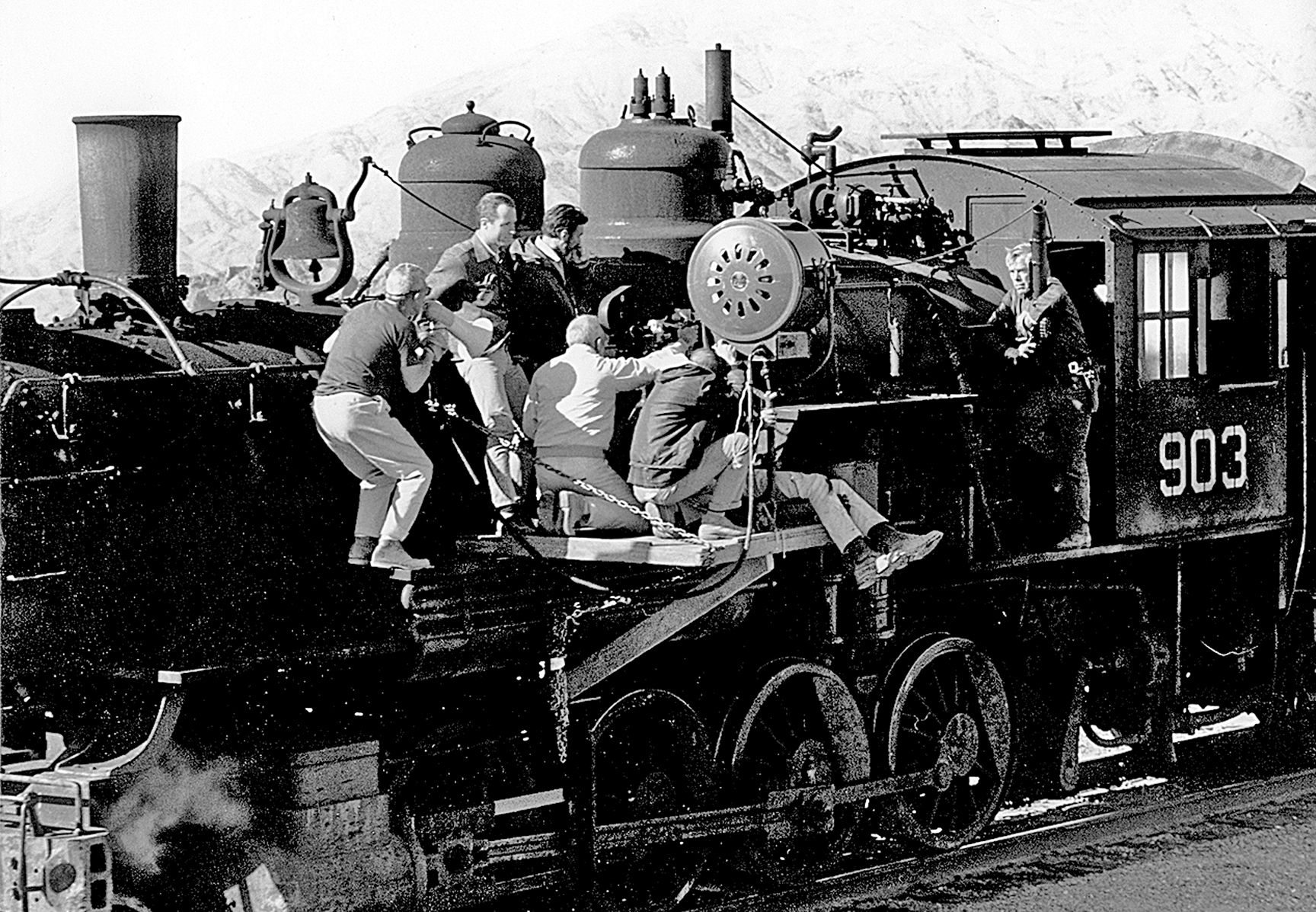
If you enjoy archival and retrospective articles on classic and influential films, you'll find more AC historical coverage here.






